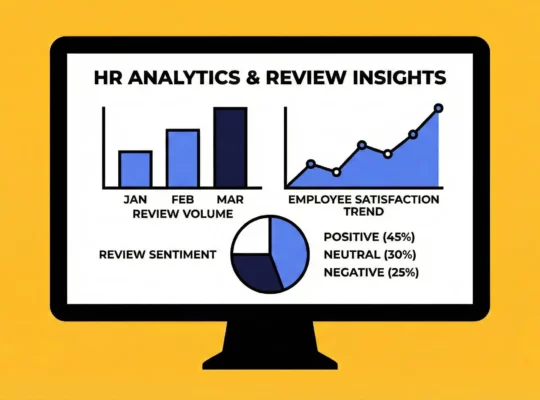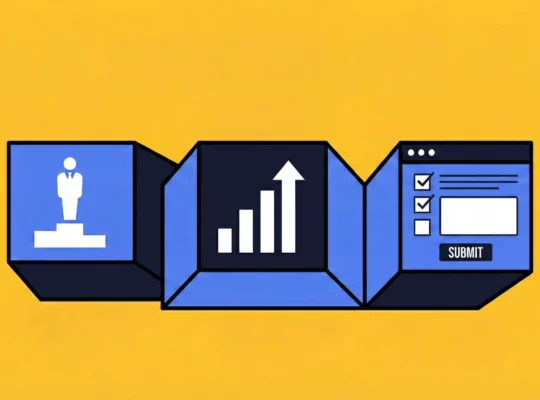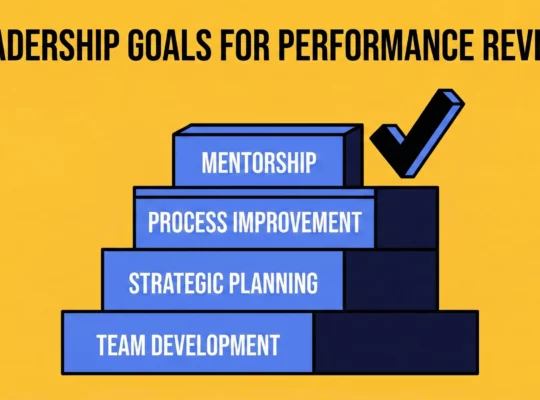Employee engagement is no longer a luxury, it’s the cornerstone of a thriving organization. At Review.jobs, we’ve witnessed firsthand the transformative power of strong employee engagement. It fosters a vibrant company culture, boosts productivity, and fuels business success. But how do you achieve this state of peak performance? In this article, we’ll delve into various employee engagement models, unpack their benefits, and equip you with the knowledge to choose the perfect fit for your organization.
- What is an Employee Engagement Model?
- Importance of Having an Employee Engagement Model
- Top 5 Employee Engagement Models
- Choosing the Right Model for Your Organization
I. What is an Employee Engagement Model?
An employee engagement model is a strategic framework that outlines the factors influencing employee satisfaction, motivation, and commitment to an organization. It provides a roadmap for companies to understand, measure, and improve employee engagement levels. These models serve as a blueprint for creating a positive and productive work environment where employees feel valued, motivated, and connected to their work.
Common Elements in Engagement Models
While specific models may vary, several core elements are commonly found in effective employee engagement frameworks:
- Employee Well-being: Prioritizing physical and mental health is essential for creating a thriving workplace.
- Recognition and Appreciation: Acknowledging and rewarding employee contributions fosters a sense of value and belonging.
- Meaningful Work: Aligning employee goals with organizational objectives creates a sense of purpose and fulfillment.
- Growth Opportunities: Providing opportunities for career advancement and skill development enhances employee satisfaction.
- Strong Leadership: Effective leadership fosters trust, motivation, and a positive work environment.
- Work-Life Balance: Supporting employees in managing their personal and professional lives enhances overall well-being.
- Open Communication: Creating channels for open dialogue and feedback fosters trust and engagement.
II. Importance of Having an Employee Engagement Model
An effective employee engagement model is the cornerstone of a thriving organization. It provides a strategic framework for understanding, measuring, and enhancing employee satisfaction, motivation, and commitment.
Purpose of Engagement Models:
- Strategic Alignment: Ensures that employee engagement initiatives are directly connected to the overall business goals and objectives. By aligning engagement efforts with the company’s strategic direction, organizations can maximize the impact of their initiatives.
- Data-Driven Decision Making: Provides a structured approach for collecting and analyzing employee feedback. By leveraging data, organizations can identify trends, measure the effectiveness of employee engagement programs, and make data-driven decisions to improve employee experiences.
- Performance Improvement: Identifies areas for improvement in employee experience and well-being. By focusing on areas where employees are most dissatisfied or disengaged, organizations can take targeted actions to enhance overall performance and productivity.
- Competitive Advantage: Cultivates a high-performance culture that attracts and retains top talent. By fostering a positive and engaging work environment, organizations can differentiate themselves from competitors and build a strong employer brand.
Benefits of Engagement Models:
- Increased Productivity: Engaged employees are more likely to be productive, innovative, and committed to achieving organizational goals.
- Improved Customer Satisfaction: Engaged employees deliver better customer experiences, leading to increased customer loyalty and advocacy.
- Reduced Turnover: High levels of employee engagement contribute to lower turnover rates, reducing recruitment and training costs and ensuring organizational stability.
- Enhanced Employer Brand: A strong employee engagement culture attracts top talent and improves the company’s reputation as an employer of choice.
- Financial Performance: Highly engaged employees contribute to a 23% increase in profitability and an overall growth in shareholder value and long-term organizational success.
III. Top 5 Employee Engagement Models
The Zinger Model
Developed by psychologist David Zinger, the Zinger Model focuses on leveraging connections between people to achieve better results. It emphasizes the importance of well-being, energy, and leveraging strengths to create a positive and engaging workplace.
Principles:
- Enhance Well-being: Prioritize physical and mental health to create a foundation for optimal performance.
- Enliven Energy: Foster a workplace culture that energizes employees and encourages passion.
- Leverage Strengths: Identify and utilize employee strengths to boost confidence and job satisfaction.
- Build Meaningful Relationships: Create opportunities for connection and collaboration among employees.
- Achieve Results: Focus on delivering outcomes that contribute to organizational success.
Success Factors:
- The Zinger Model’s emphasis on well-being and employee strengths aligns with modern workforce expectations.
- By focusing on building relationships and fostering a positive work environment, the model contributes to increased job satisfaction and employee engagement.
- The pyramid structure of the model provides a clear framework for implementing engagement initiatives.
The Gallup Model
Developed by Gallup, a renowned research and consulting firm, the Gallup Model is a widely used framework for measuring employee engagement through its 12-question survey. It focuses on identifying the key drivers of employee satisfaction and performance.
Principles:
- Clear Expectations: Employees understand what is expected of them at work.
- Opportunities to Excel: Employees have the opportunity to do what they do best every day.
- Recognition and Rewards: Employees receive recognition for their contributions.
- Career Growth and Development: Employees have opportunities to learn and grow.
- Well-being: Employees care about each other and have a sense of belonging.
- Leadership and Management: Employees have a leader who cares about them as people and encourages their development.
Success Factors:
- The Gallup Model’s focus on actionable items makes it easy to implement engagement initiatives.
- The 12-question survey provides a quick and efficient way to measure employee engagement.
- The model emphasizes the importance of managers in driving employee engagement.
The AON-Hewitt Model
The AON-Hewitt Model emphasizes the connection between employee engagement and business outcomes, providing a clear framework for identifying areas of strength and opportunities for improvement. It focuses on three key attributes: Say, Stay, and Strive.
Principles:
- Say: Employees speak positively about the organization, their work, and their colleagues.
- Stay: Employees feel a strong sense of belonging and desire to remain with the organization.
- Strive: Employees are motivated and exert effort toward success in their jobs and for the company.
Success Factors:
- Clear Link to Business Outcomes: The model directly connects employee engagement to key business metrics, such as customer satisfaction, productivity, and turnover.
- Comprehensive Approach: By focusing on Say, Stay, and Strive, the model provides a holistic view of employee engagement.
- Actionable Insights: The model offers actionable insights into areas for improvement, such as enhancing communication, improving work-life balance, or providing more growth opportunities.
The Deloitte Model
The Deloitte Model emphasizes creating a holistic and employee-centric workplace culture. This model aims to create an “irresistible organization” by focusing on five core elements: meaningful work, a positive work environment, hands-on management, growth opportunities, and leadership trust.
Principles:
- Meaningful Work: Employees feel their work contributes to something larger than themselves and aligns with their personal values.
- Positive Work Environment: The workplace fosters collaboration, inclusivity, and well-being.
- Hands-On Management: Leaders are accessible, supportive, and provide clear guidance.
- Growth Opportunities: Employees have clear paths for career development and skill enhancement.
- Leadership Trust: Employees trust their leaders to make sound decisions and prioritize employee well-being.
Success Factors:
- Employee Satisfaction and Retention: By focusing on meaningful work, a positive environment, and growth opportunities, the model enhances employee job satisfaction and reduces turnover.
- Strong Employer Brand: An irresistible organization attracts top talent and improves the company’s reputation as an employer of choice.
- Enhanced Performance: Engaged and motivated employees contribute to increased productivity and innovation.
The Kahn Model
Developed by William Kahn, the Kahn Model focuses on the psychological experience of employees. The so-called father of employee engagement emphasizes the importance of creating a supportive and inclusive work environment where employees feel empowered to contribute their full selves through meaningfulness, safety, and availability.
Principles:
- Meaningfulness: Employees perceive their work as valuable, important, and aligned with their personal values.
- Safety: Employees feel psychologically safe to take risks, express opinions, and make mistakes without fear of negative consequences.
- Availability: Employees have the necessary resources, support, and opportunities to perform their jobs effectively.
Success Factors:
- Enhanced Employee Well-being: By fostering a sense of meaningfulness and safety, the Kahn Model contributes to improved employee well-being and job satisfaction.
- Increased Employee Engagement: When employees feel psychologically safe and their work is meaningful, they are more likely to be engaged and committed to their roles.
- Improved Organizational Performance: A psychologically safe environment encourages innovation, creativity, and collaboration, leading to better business outcomes.
IV. Choosing the Right Model for Your Organization
Imagine your organization as a high-performance race car. A well-chosen employee engagement model is like the finely tuned engine that propels you toward success. But just as a Formula One car wouldn’t perform optimally on a dirt track, the best engagement model for your organization depends on several key factors. Let’s delve into the elements that will help you find the perfect fit.
Assessing Organizational Needs – Understanding the Engine
Just like a mechanic analyzes a car before a race, you need to assess your organization’s unique needs. Here are some key considerations:
Company Size and Structure
The size and structure of your organization can significantly influence the best-fit engagement model.
- Large Corporations: Typically benefit from structured models like AON-Hewitt or Deloitte, offering clear frameworks and measurable outcomes to manage a vast workforce.
- Smaller Companies and Startups: Often thrive with the flexibility of Gallup or the emotional focus of Zinger, adapting to rapid changes and fostering a close-knit culture.
Industry Considerations
Industry-specific challenges and demands shape the ideal engagement model. For example:
- High-stress industries like healthcare or finance might find the JD-R model’s emphasis on balancing job demands particularly relevant.
- Fast-paced, innovative sectors might lean towards models that prioritize employee autonomy and growth, such as the Gallup or Deloitte models.
Cultural Fit
A successful engagement model aligns with your organization’s existing culture.
- Transparent and inclusive cultures: The Kahn model’s emphasis on psychological safety might be a natural fit.
- Performance-driven cultures: Models like AON-Hewitt, with a strong focus on business outcomes, can be effective.
Identifying Key Engagement Drivers – Listening to Your Engine’s Purr
Understanding your employees’ needs and preferences is like listening to your engine’s purr to assess its performance. Here’s how to tune in:
Unlock Employee Insights with Review.jobs
Building a thriving and engaged workforce requires understanding your employees’ needs and aspirations. Traditional feedback methods can be one-sided or miss crucial aspects of the employee experience. This is where Review.jobs comes in, a powerful platform designed to facilitate candid and insightful employee feedback.
Overview
Review.jobs is a next-generation employee review platform that goes beyond basic surveys. It empowers organizations to gather comprehensive and actionable insights from their workforce, fostering a culture of open communication and continuous improvement.
Key Features for Unparalleled Employee Feedback
1. Diverse Collection Methods: Review.jobs provides a versatile toolkit for gathering feedback, ensuring you capture the full picture of employee experience. Here’s what you get:
- Employee Satisfaction Surveys: Utilize our employee satisfaction surveys to gauge overall employee sentiment across various aspects of work, like work-life balance, career development opportunities, and management effectiveness.
- Custom Review Collection Surveys: Tailor surveys to address specific topics or initiatives, allowing for more focused feedback and deeper insights.
- API Integrations: Integrate Review.jobs seamlessly with your existing HR or performance management systems for a streamlined data collection and analysis process.
2. Guaranteed Anonymity: Transparency and trust are vital for honest feedback. Review.jobs prioritizes employee anonymity through:
- Secure Feedback Requests: Multi-layered security ensures that only authenticated users can initiate feedback requests.
- Anonymous Review Submissions: Employees can submit feedback confidently, knowing their identities are completely anonymized. This promotes open and honest feedback, crucial for uncovering deeper issues or opportunities for improvement.
3. Focus on Authenticity:
Not all feedback is created equal. Review.jobs prioritizes genuine feedback over incentivized responses. This ensures that the collected data holds true value and reflects real employee experiences.
The Power of Authentic Employee Feedback
Authentic employee feedback is the cornerstone of understanding your workforce. Through Review.jobs, you can gather valuable insights into:
- Employee Needs and Preferences: Understand what motivates and disengages your employees, allowing you to tailor strategies for enhanced engagement and satisfaction.
- Emerging Trends and Issues: Identify potential problems before they escalate, allowing for proactive solutions to maintain a positive work environment.
- Areas for Improvement: Gain data-driven insights into specific aspects of your company culture, fostering continuous improvement and a commitment to employee well-being.
Leadership Style and Commitment
The success of any engagement model depends heavily on leadership buy-in and commitment. Effective leadership plays a pivotal role in fostering a positive work environment and driving employee engagement.
- Transformational Leadership: Inspiring and motivating employees to achieve organizational goals can significantly boost engagement levels.
- Servant Leadership: Focusing on the needs of employees and empowering them to succeed can foster a strong sense of loyalty and commitment.
- Coaching Leadership: Providing guidance and support for employee development can enhance job satisfaction and engagement.
Customizing Engagement Strategies – Fine-Tuning for Peak Performance
A one-size-fits-all approach rarely yields optimal results when it comes to employee engagement. To maximize its impact, organizations must tailor their strategies to their specific needs.
Combining Elements from Different Models
- Hybrid Approach: Draw inspiration from multiple models to create a comprehensive and tailored engagement strategy.
- Complementary Strengths: Identify the strengths of each model and combine them to address different aspects of employee engagement.
- Avoiding Overlap: Ensure that the selected elements from different models complement each other and don’t create redundancies.
Continuous Evaluation and Adaptation
- Regular Assessment: Monitor employee engagement levels and collect feedback consistently.
- Data-Driven Adjustments: Use data and analytics to identify areas for improvement and make necessary changes to the engagement strategy.
- Agile Approach: Embrace a flexible and adaptable mindset to respond to evolving employee needs and business conditions.
Integration with Business Objectives
- Alignment with Strategic Goals: Ensure that employee engagement initiatives support the overall business strategy.
- Measurable Impact: Define key performance indicators (KPIs) to track the impact of engagement initiatives on business outcomes.
- Resource Allocation: Allocate appropriate resources to support the implementation and ongoing management of engagement strategies.
Practical Steps for Implementation – Putting Your Engine to the Test
Now that you’ve selected and customized your employee engagement model, it’s time to bring it to life. Here are some practical steps to guide your implementation:
Pilot Programs
- Targeted Testing: Select a representative department or team to pilot the chosen engagement model. This allows for focused testing and data collection before a full-scale rollout.
- Data Collection: Gather feedback and performance metrics during the pilot phase to assess its effectiveness.
- Iterative Improvement: Use insights from the pilot to refine the model before expanding it to the entire organization.
Training and Development
- Manager Training: Equip managers with soft skills, tools, and knowledge to implement engagement initiatives effectively. Focus on communication, coaching, and feedback skills.
- Employee Empowerment: Provide employees with the necessary resources and training to understand and participate in engagement activities.
- Change Management Support: Offer support and guidance to help employees adapt to new engagement initiatives.
Communication and Transparency
- Clear Communication: Clearly articulate the goals and benefits of the employee engagement model to all employees. According to a survey conducted by Gallup, clear communication about goals and expectations can reduce turnover by 22% and a 10% increase in productivity.
- Transparent Updates: Provide regular updates on the progress of engagement initiatives and share the results of employee feedback.
- Open Dialogue: Foster open communication channels to encourage employee input and suggestions.
Understanding and implementing effective employee engagement models can transform your organization. These models provide the frameworks and strategies necessary to enhance employee satisfaction, reduce turnover, and improve overall business outcomes. At Review.jobs, we offer tools to collect authentic employee feedback, ensuring your engagement strategies are rooted in genuine insights. Start exploring the right engagement model for your organization today and witness the positive impact on your workplace.





